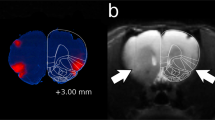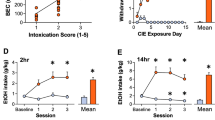Abstract
Exposure of alcohol addicts to alcohol-related environmental cues may elicit alcohol-seeking behavior and lead to relapse to heavy drinking. The aim of the present study was to identify brain regions activated by alcohol (ethanol)-related stimuli in Wistar rats trained to lever press for 8% ethanol solution in operant self-administration cages. Ethanol self-administration was stabilized in a maintenance phase, which lasted for 30 days. c-Fos protein expression was used as a marker of neuronal activation.
Re-exposure to ethanol self-administration environment after 30-day but not after 24-h abstinence increased the number of Fos-positive nuclei in the thalamic paraventricular nucleus, granular insular cortex and medial prefrontal cortex. In general, no differences were found in c-Fos protein expression between the rats allowed to self-administer alcohol and the subjects exposed only to alcohol-related stimuli. In contrast, no increase in c-Fos immunoreactivity was observed in rats trained to lever press for sucrose solution and exposed to sucrose-related environmental stimuli after 30-day abstinence.
Taken together, these results suggest that at least some thalamo-cortical circuits become more responsive to ethanol-paired stimuli after prolonged abstinence and that ethanol- and sucrose-seeking behavior may be regulated by partially different neural mechanism(s).



Similar content being viewed by others
References
Abrams DB, Monti PM, Carey KB, Pinto RP, Jacobus SI (1988) Reactivity to smoking cues and relapse: two studies of discriminant validity. Behav Res Ther 26:225–233
Ahmed SH, Koob G (1997) Cocaine- but not food-seeking behavior is reinstated by stress after extinction. Psychopharmacology 132:289–295
Augustine JR (1996) Circuitry and functional aspects of the insular lobe in primates including humans. Behav Brain Res 22:229–244
Bachtell RK, Wang Y-M, Freeman P, Risinger F, Ryabinin AE (1999) Alcohol drinking produces brain region-selective changes in expression of inducible transcription factors. Brain Res 847:157–165
Bienkowski P, Kostowski W, Koros E (1999a) The role of drug-paired stimuli in extinction and reinstatement of ethanol-seeking behavior in the rat. Eur J Pharmacol 374:315–319
Bienkowski P, Kostowski W, Koros E (1999b) Ethanol-reinforced behavior in the rat: effects of naltrexone. Eur J Pharmacol 374:321–327
Bienkowski P, Koros E, Kostowski W, Bogucka-Bonikowska A (2000) Reinstatement of ethanol seeking in rats: behavioral analysis. Pharmacol Biochem Behav 66:123–128
Brown EE, Robertson GS, Fibiger HC (1992) Evidence for conditional neuronal activation following exposure to a cocaine-paired environment: role of forebrain limbic structures. J Neurosci 12:4112–4121
Buczek Y, Le AD, Wang A, Stewart J, Shaham Y (1999) Stress reinstates nicotine seeking but not sucrose solution seeking in rats. Psychopharmacology 144:183–188
Chang SL, Patel NA, Romero AA (1995) Activation and desensitization of Fos immunoreactivity in the rat brain following ethanol administration. Brain Res 679:89–98
Chaudhuri A (1997) Neural activity mapping with inducible transcription factors. Neuroreport 8:iii–vii
Childress AR, Mozley PD, McElgin W, Fitzgerald J, Reivich M, O’Brien C (1999) Limbic activation during cue-induced cocaine-craving. Am J Psychiatry 156:11–18
Ciccocioppo R, Angeletti S, Weiss F (2001a) Long-lasting resistance to extinction of response reinstatement induced by ethanol-related stimuli: role of genetic ethanol preference. Alcohol Clin Exp Res 25:1414–1419
Ciccocioppo R, Sanna PP, Weiss F (2001b) Cocaine-predictive stimulus induces drug-seeking behavior and neural activation in limbic brain regions after multiple months of abstinence: reversal by D1 antagonists. Proc Nat Acad Sci USA 98:1976–1981
Di Chiara G (1999) Drug addiction as dopamine-dependent associative learning disorder. Eur J Pharmacol 375:13–30
Divac I, Mogensen J, Petrovic-Minic B, Zilles K, Regidor J (1993) Cortical projections of the thalamic mediodorsal nucleus in the rat. Definition of the prefrontal cortex. Acta Neurobiol Exp 53:425–429
Drummond DC (2000) What does cue-reactivity have to offer clinical research? Addiction 95:S129–S144
Drummond DC, Glautier S (1994) A controlled trial of cue exposure treatment in alcohol dependence. J Consult Clin Psychol 62:809–817
Drummond DC, Cooper T, Glautier S (1990) Conditioned learning in alcohol dependence: implications for cue exposure treatment. Br J Addict 85:725–743
Erdtmann-Vourliotis M, Mayer P, Riechert U, Hollt V (1999) Acute injection of drugs with low addictive potential (delta(9)-tetrahydrocannabinol, 3,4-methylenedioxymethamphetamine, lysergic acid diamide) causes a much higher c-fos expression in limbic brain areas than highly addicting drugs (cocaine and morphine). Mol Brain Res 71:313–324
Garavan H, Pankiewicz J, Bloom A, Cho J-K, Sperry L, Ross TJ, Salmeron BJ, Risinger R, Kelley D, Stein EA (2000) Cue-induced cocaine craving: neuroanatomical specificity for drug users and drug stimuli. Am J Psychiatry 157:1789–1798
Gawin FH, Kleber HD (1986) Abstinence symptomatology and psychiatric diagnosis in cocaine abusers. Clinical observations. Arch Gen Psychiatry 43:103–113
George MS, Anton RF, Bloomer C, Teneback C, Drobes DJ, Lorberbaum JP, Nahas Z, Vincent DJ (2001) Activation of prefrontal cortex and anterior thalamus in alcoholic subjects on exposure to alcohol-specific cues. Arch Gen Psychiatry 58:345–352
Grant S, London E, Newlin DB, Villemagne DL, Liu X, Contoreggi C, Phillips RL, Kimes AL, Margolin A (1996) Activation of memory circuits during cue-elicited cocaine craving. Proc Natl Acad Sci USA 93:12040–12045
Grimm JW, Shaham Y, Hope BT (2002) Effect of cocaine and sucrose withdrawal period on extinction behavior, cue-induced reinstatement, and protein levels of the dopamine transporter and tyrosine hydroxylase in limbic and cortical areas in rats. Behav Pharmacol 13:379–388
Hitzemann B, Hitzemann R (1997) Genetics ethanol and the Fos response: a comparison of the C57BL/6 J and DBA/2 J inbred mouse strains. Alcohol Clin Exp Res 21:1497–1507
Hotsenpiller G, Horak BT, Wolf ME (2002) Dissociation of conditioned locomotion and Fos induction in response to stimuli formerly paired with cocaine. Behav Neurosci 116:634–645
Kaczmarek L (2000) Gene expression in learning processes. Acta Neurobiol Exp 60:419–424
Kanaka TS, Balasubramaniam V (1978) Stereotactic cingulumotomy for drug addiction. Appl Neurophysiol 41:86–92
Katner SN, Magalong JG, Weiss F (1999) Reinstatement of alcohol-seeking behavior by drug-associated discriminative stimuli after prolonged extinction in the rat. Neuropsychopharmacology 20:471–479
Kilts CD, Schweitzer JB, Quinn CK, Gross RE, Faber TL, Muhammad F, Ely TD, Hoffman JM, Drexler KP (2001) Neural activity related to drug craving in cocaine addiction. Arch Gen Psychiatry 58:334–341
Liste L, Guerra MJ, Caruncho H, Labandeira-Garcia JL (1997) Treadmill running induces striatal Fos expression via NMDA glutamate and dopamine receptors. Exp Brain Res 115:458–468
Maas LC, Lukas SE, Kaufman MJ, Weiss RD, Daniels SL, Rogers VW, Kukes TJ, Renshaw PF (1998) Functional magnetic resonance imaging of human brain activation during cue-induced cocaine craving. Am J Psychiatry 155:124–126
Mackowiak M, Chocyk A, Fijal K, Czyrak A, Wedzony K (1999) c-Fos proteins, induced by the serotonin receptor agonist DOI, are not expressed in 5-HT2A positive cortical neurons. Mol Brain Res 71:358–363
McGregor IS, Saharov T, Hunt GE, Topple AN (1999) Beer consumption in rats: the influence of ethanol content, food deprivation, and cocaine. Alcohol 17:47–56
Monti PM, Rohsenow DJ, Hutchison KE, Swift RM, Mueller TI, Colby SM, Brown RA, Gulliver SB, Gordon A, Abrams DB (1999) Naltrexone’s effect on cue-elicited craving among alcoholics in treatment. Alcohol Clin Exp Res 23:1386–1394
Neisewander JL, Baker DA, Fuchs RA, Tran-Nguyen LTL, Palmer A, Marshall J (2000) Fos protein expression and cocaine-seeking behavior in rats after exposure to a cocaine self-administration environment. J Neurosci 20:798–805
Nisell M, Nomikos GG, Chergui K, Grillner P, Svensson TH (1997) Chronic nicotine enhances basal and nicotine-induced Fos immunoreactivity preferentially in the medial prefrontal cortex. Neuropsychopharmacology 17:151–161
Paxinos G, Watson C (1986) The rat brain in stereotaxic coordinates. Academic Press, San Diego
Piasecki J, Koros E, Dyr W, Kostowski W, Danysz W, Bienkowski P (1998) Ethanol-reinforced behavior in the rat: effects of uncompetitive NMDA receptor antagonist, memantine. Eur J Pharmacol 354:135–143
Rodriguez de Fonseca F, Navarro M (1998) Role of the limbic system in dependence on drugs. Ann Med 30:397–405
Rohsenow DJ, Monti PM, Abrams DB, Rubonis AV, Niaura VS, Colby SM, Wunshel SM, Abrams DB (1994) Cue-reactivity as a predictor of drinking among male alcoholics. J Consult Clin Psychol 62:620–626
Rolls ET (1997) Taste and olfactory processing in the brain and its relation to the control of eating. Crit Rev Neurobiol 11:263–287
Rolls ET (2000) The orbitofrontal cortex and reward. Cereb Cortex 10:284–294
Rosenkranz JA, Grace AA (2002) Cellular mechanisms of infralimbic and prelimbic prefrontal cortical inhibition and dopaminergic modulation of basolateral amygdala neurons in vivo. J Neurosci 22:324–337
Ryabinin AE, Bachtell RK, Freeman P, Risinger FO (2001) ITF expression in mouse brain during acquisition of alcohol self-administration. Brain Res 890:192–195
Samson HH (1986) Initiation of ethanol reinforcement using a sucrose-substitution procedure in food- and water-sated rats. Alcohol Clin Exp Res 10:436–442
Schneider F, Habel U, Wagner M, Franke P, Salloum M, Shah NJ, Toni L, Sulzbach C, Honig K, Maier W, Gaebel W, Zilles K (2001) Subcortical correlates of craving in recently abstinent alcoholic patients. Am J Psychiatry 158:1075–1083
Schroeder BE, Holahan MR, Landry CF, Kelley AE (2000) Morphine-associated environmental cues elicit conditioned gene expression. Synapse 37:146–158
Schroeder BE, Binzak MJ, Kelley AE (2001) A common profile of prefrontal cortical activation following exposure to nicotine- or chocolate-associated contextual cues. Neuroscience 105:535–545
Shaham Y, Erb S, Stewart J (2000) Stress-induced relapse to heroin and cocaine seeking in rats: a review. Brain Res Rev 33:13–33
Shalev U, Morales M, Hope BT, Yap J, Shaham Y (2001) Time-dependent changes in extinction behavior and stress-induced reinstatement of drug-seeking following withdrawal from heroin in rats. Psychopharmacology 156:98–107
Sinclair JD (2001) Evidence about the use of naltrexone and for different ways of using it in the treatment of alcoholism. Alcohol Alcohol 36:2–10
Su HS, Bentivoglio M (1990) Thalamic midline cell populations projecting to the nucleus accumbens, amygdala, and hippocampus in the rat. J Comp Neurol 297:582–593
Thiele TE, van Dijk G, Bernstein IL (1997) Ethanol-induced c-Fos expression in rat lines selected for low and high alcohol consumption. Brain Res 756:278–282
Topple AN, Hunt GE, McGregor IS (1998) Possible neural substrates of beer-craving in rats. Neurosci Lett 252:99–102
Tran-Nguyen LTL, Fuchs RA, Coffey GP, Baker DA, O’Dell LA, Neisewander JL (1998) Time-dependent changes in cocaine-seeking behavior and extracellular dopamine levels in the amygdala during cocaine withdrawal. Neuropsychopharmacology 19:48–59
Tran-Nguyen LTL, Bellew JG, Grote KA, Neisewander JL (2001) Serotonin depletion attenuates cocaine seeking but enhances sucrose seeking and the effects of cocaine priming on reinstatement of cocaine seeking in rats. Psychopharmacology 157:340–348
Vertes RP (2002) Analysis of projections from the medial prefrontal cortex to the thalamus in the rat, with emphasis on nucleus reuniens. J Comp Neurol 442:163–187
Volkow ND, Fowler JS (2000) Addiction, a disease of compulsion and drive: involvement of the orbitofrontal cortex. Cereb Cortex 10:318–325
Wang G-J, Volkow ND, Fowler JS, Cervany P, Hitzemann RJ, Pappas NR, Wong CT, Felder Ch (1999) Regional brain metabolic activation during craving elicited by recall of previous drug experiences. Life Sci 64:775–784
Weitemier AZ, Woerner A, Backstrom P, Hyytia P, Ryabinin AE (2001) Expression of c-Fos in Alko Alcohol rats responding for ethanol in an operant paradigm. Alcohol Clin Exp Res 25:704–710
Wexler BE, Gottschalk CH, Fulbright RK, Prohovnik I, Lacadie CM, Rounsaville BJ, Gore JC (2001) Functional magnetic resonance imaging of cocaine craving. Am J Psychiatry 158:86–95
Wu JC, Bell K, Najafi A, Widmark C, Keator D, Tang Ch, Klein E, Bunney BG, Fallon J, Bunney WE (1997) Decreasing striatal 6-FDOPA uptake with increasing duration of cocaine withdrawal. Neuropsychopharmacology 17:402–409
Acknowledgment
The study was supported by the State Committee for Scientific Research (grants no. 4P05A 08 317 and PBZ-KBN-033/P05/2002).
Author information
Authors and Affiliations
Corresponding author
Rights and permissions
About this article
Cite this article
Wedzony, K., Koros, E., Czyrak, A. et al. Different pattern of brain c-Fos expression following re-exposure to ethanol or sucrose self-administration environment. Naunyn-Schmiedeberg's Arch Pharmacol 368, 331–341 (2003). https://doi.org/10.1007/s00210-003-0811-7
Received:
Accepted:
Published:
Issue Date:
DOI: https://doi.org/10.1007/s00210-003-0811-7




